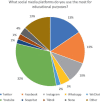Impact of Social Media and Virtual Learning on Cardiology During the COVID-19 Pandemic Era and Beyond
- PMID: 33133368
- PMCID: PMC7587312
- DOI: 10.14797/mdcj-16-3-e1
Impact of Social Media and Virtual Learning on Cardiology During the COVID-19 Pandemic Era and Beyond
Abstract
Over the past decade, advances in digital trends and technology have greatly impacted the medical field with rapid delivery of and access to information. The field of cardiovascular medicine in particular has seen major technological advances and is well versed in the use of digital platforms and social media. In these unprecedented times of the COVID-19 pandemic, social media and other digital platforms are essential tools for communication, education, and delivery of information. In this review, we discuss the ways virtual learning and social media are changing medical education and research.
Keywords: COVID-19; cardiology virtual learning; social media.
© 2020 Houston Methodist Hospital Houston, Texas.
Conflict of interest statement
Conflict of Interest Disclosure: The author has completed and submitted the Methodist DeBakey Cardiovascular Journal Conflict of Interest Statement and none were reported.
Figures






Similar articles
-
ACC.20: Impact of social media at the virtual scientific sessions during the COVID-19 pandemic.Clin Cardiol. 2020 Sep;43(9):944-948. doi: 10.1002/clc.23387. Epub 2020 Jul 3. Clin Cardiol. 2020. PMID: 32618358 Free PMC article.
-
[Implementation of a virtual rotation in Cardiology in times of COVID-19].Medicina (B Aires). 2020;80(5):587-588. Medicina (B Aires). 2020. PMID: 33048814 Spanish. No abstract available.
-
The Early Influence and Effects of the Coronavirus Disease 2019 (COVID-19) Pandemic on Resident Education and Adaptations.J Am Coll Radiol. 2020 Oct;17(10):1322-1328. doi: 10.1016/j.jacr.2020.07.022. Epub 2020 Jul 22. J Am Coll Radiol. 2020. PMID: 32818485 Free PMC article. Review.
-
Exercise Caution When Sharing Medical Advice About Coronavirus on Social Media.Popul Health Manag. 2020 Oct;23(5):400. doi: 10.1089/pop.2020.0089. Epub 2020 May 18. Popul Health Manag. 2020. PMID: 32421385 Free PMC article. No abstract available.
-
The Evolving Pandemic of COVID-19 and Interventional Cardiology.Catheter Cardiovasc Interv. 2020 Sep 1;96(3):507-508. doi: 10.1002/ccd.28894. Epub 2020 Apr 12. Catheter Cardiovasc Interv. 2020. PMID: 32279447 Free PMC article. Review. No abstract available.
Cited by
-
Tweet me: conferencing in the era of COVID-19 and 280 characters.Clin Kidney J. 2021 Apr 7;14(10):2142-2150. doi: 10.1093/ckj/sfab075. eCollection 2021 Oct. Clin Kidney J. 2021. PMID: 34603691 Free PMC article.
-
Influence of Social Media on the Dissemination and Uptake of Cardiology Research.Cureus. 2025 Jun 21;17(6):e86509. doi: 10.7759/cureus.86509. eCollection 2025 Jun. Cureus. 2025. PMID: 40698205 Free PMC article. Review.
-
Social media for cardiovascular journals: State of the art review.Am Heart J Plus. 2021 Aug;8:100041. doi: 10.1016/j.ahjo.2021.100041. Epub 2021 Aug 4. Am Heart J Plus. 2021. PMID: 34604825 Free PMC article.
-
#COVID19 and #Breastcancer: A Qualitative Analysis of Tweets.Curr Oncol. 2022 Nov 8;29(11):8483-8500. doi: 10.3390/curroncol29110669. Curr Oncol. 2022. PMID: 36354729 Free PMC article. Review.
-
The Pandemic and Beyond: Innovation in Cardiovascular Training to Improve Quality of Education and Trainees' Well-being.Methodist Debakey Cardiovasc J. 2022 Jun 3;18(3):78-86. doi: 10.14797/mdcvj.1107. eCollection 2022. Methodist Debakey Cardiovasc J. 2022. PMID: 35734158 Free PMC article. Review.
References
-
- Santoro E, Caldarola P, Villella A. [Using Web 2.0 technologies and social media for the cardiologist's education and update] G Ital Cardiol (Rome) 2011;12:174–81. - PubMed
-
- Snipelisky D. Social Media in Medicine: A Podium Without Boundaries. J Am Coll Cardiol. 2015;65:2459–61. - PubMed
-
- Walsh MN. Social Media and Cardiology. J Am Coll Cardiol. 2018;71:1044–1047. - PubMed
-
- Parwani P, Choi AD, Lopez-Mattei J, et al. Understanding Social Media: Opportunities for Cardiovascular Medicine. J Am Coll Cardiol. 2019;73:1089–93. - PubMed
-
- Kemp S. Digital 2019: Global Digital Overview. DataReportal website. 2019 Jan 31; https://datareportal.com/reports/digital-2019-global-digital-overview
Publication types
MeSH terms
LinkOut - more resources
Full Text Sources
Miscellaneous

